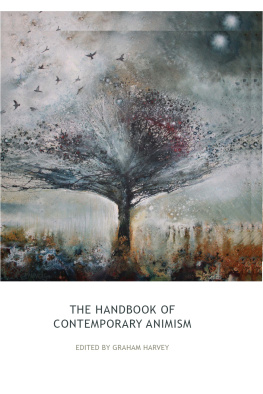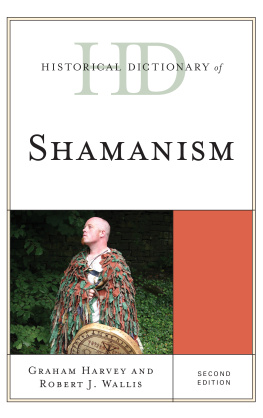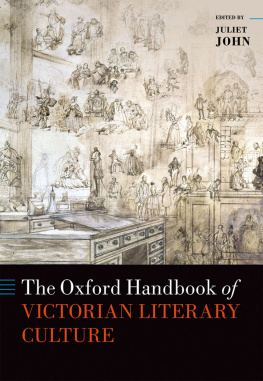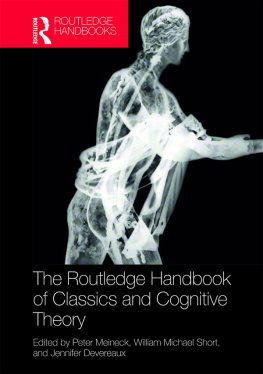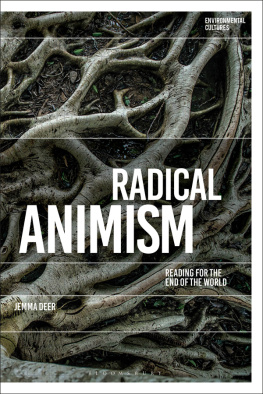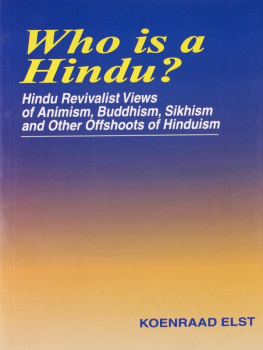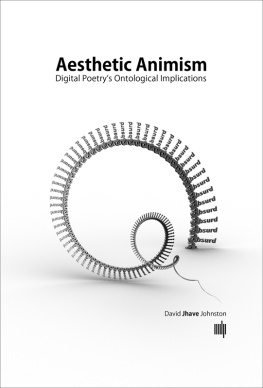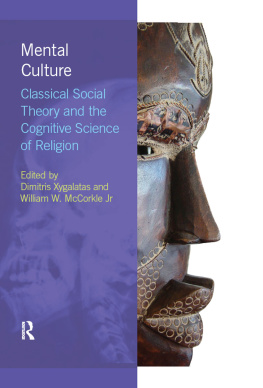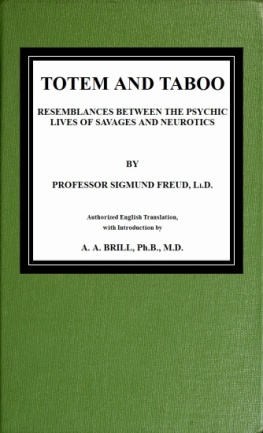
THE HANDBOOK OF CONTEMPORARY ANIMISM
THE HANDBOOK OF CONTEMPORARY ANIMISM
Edited by Graham Harvey

First published in 2013 by Acumen
Published 2014 by Routledge
2 Park Square, Milton Park, Abingdon, Oxon OX14 4RN
711 Third Avenue, New York, NY 10017, USA
Routledge is an imprint of the Taylor and Francis Group, an informa business
Editorial matter and selection Graham Harvey, 2013.
Individual chapters the contributors, 2013.
This book is copyright under the Berne Convention.
No reproduction without permission.
All rights reserved. No part of this book may be reprinted or reproduced or utilised in any form or by any electronic, mechanical, or other means, now known or hereafter invented, including photocopying and recording, or in any information storage or retrieval system, without permission in writing from the publishers.
Notices
Practitioners and researchers must always rely on their own experience And knowledge in evaluating and using any information, methods, compounds, or experiments described herein. In using such information or methods they should be mindful of their own safety and the safety of others, including parties for whom they have a professional responsibility.
To the fullest extent of the law, neither the Publisher nor the authors, contributors, or editors, assume any liability for any injury and/or damage to persons or property as a matter of products liability, negligence or otherwise, or from any use or operation of any methods, products, instructions, or ideas contained in the material herein.
ISBN: 978-1-84465-711-7 (hardcover)
British Library Cataloguing-in-Publication Data
A catalogue record for this book is available from the British Library.
Contents
Graham Harvey
Linda Hogan
Danny Naveh and Nurit Bird-David
Kenneth M. Morrison
Robert A. Segal
Martin D. Stringer
Philippe Descola
Laura Rival
Signe Howell
Paul-Franois Tremlett
David Abram
Deborah Bird Rose
Rane Willerslev
Colin Scott
Fritz Detwiler
Douglas Ezzy
Priscilla Stuckey
Tim Ingold
Tord Olsson
Alf Hornborg
Amy Whitehead
Rane Willerslev
Roberte Hamayon
Isabella Lepri
Robert J. Wallis
Paul Christopher Johnson
Andy Letcher
Stewart Guthrie
Max Velmans
Stephan Harding
Matthew Hall
Marc Bekoff
Adrian Harris
M. J. Barrett
Jenny Blain
Val Plumwood
Graham Harvey
Patrick Curry
Casey Brienza
Olu Taiwo
Ronald Grimes
Graham Harvey
Animism is a hard-working word. It identifies a range of interesting phenomena but also labels several distinct ways of understanding such matters. The Handbook of Contemporary Animism brings together expert contributors to debates in which the term animism is now playing a role. It is intended to advance discussion rather than either merely describe its current state or to bring it to a conclusion. It does this by allowing animism to continue working hard by referring to more than one thing or theory while also aiding our efforts to understand the meeting-points of shared interest and difference between contributors. One task of this introduction is to say something about that range and to make sense of the use of one word to convey different meanings. It will conclude that diversity provides refreshing perspectives and provokes new ideas and practices by requiring us to test and reconsider (and sometimes defend) our familiar views and approaches. In the most general terms, animism concerns the nature of human-being and the nature of our world but what animates the contributors to this book is that these large questions are addressed in specific relationships, etiquettes, activities, ideas and encounters. Therefore, a blend of description and theorizing provide the most common ways in which we engage with animism.
WAYS INTO STUDYING ANIMISM
My interest in animism was initiated in ways that are distinctive but not entirely alien to other contributors to this book. I suspect that I first heard of animism in introductory undergraduate lectures about the history of the academic study of religion. The influence of Victorian anthropologists like Edward Tylor (who defined animism as the characteristically religious belief in spirits) is bound to have been mentioned. This failed to interest me at the time. Postdoctoral research among varied groups of Pagans brought me into contact with people who named themselves animists. What initially intrigued me was that the name seemed to be used in two seemingly contrasting ways. Some Pagans identified animism as the part of their religious practice or experience which involved encounters with tree-spirits, river-spirits or ancestor-spirits. This animism was metaphysical and would have been recognized by Tylor. Other Pagans seemed to use animism as a shorthand reference to their efforts to re-imagine and redirect human participation in the larger-than-human, multi-species community. This animism was relational, embodied, eco-activist and often naturalist rather than metaphysical. In writing about this tension initially in a journal article about Pagan cosmologies and later in a book-length introduction to contemporary Paganisms (G. Harvey 1993, 2006c) I contrasted those discourses and rituals involving spirits with those that might involve hedgehogs. (I selected hedgehogs as an example of a creature endangered by human lifestyles and therefore as indicative of this-worldly and environmentalist trends among some Pagans.) These really should not be taken as strong contrasts but as exemplary of influential esoteric and animist currents in the ongoing evolution of Pagan thought and behaviour (see G. Harvey 2011a; Jamison 2011; Rountree 2012).
In an early publication about Paganism (1993), I cited Irving Hallowells (1960) article, Ojibwa Ontology, Behavior, and World View, primarily in order to use his phrase other-than-human persons. I also cited Te Pakaka Tawhais discussion of Maori Religion (2002) in which he defines the purpose of religious activity (among his people at least) as doing violence with impunity. He explains that such activity neither reaches for redemption and salvation, nor conveys messages of praise and thanksgiving, but seeks permission and offers placation (ibid.: 244). It places religious activity firmly in this-worldly interactions between, for example, humans and trees or sweet potatoes. Hallowell and Tawhai have had a major impact on the direction of my research, and the phrases other-than-human persons and doing violence with impunity have become foundational in my efforts to understand animism and, most recently, to redefine what religion might mean (G. Harvey 2013). I soon discovered that Hallowells article was gaining influence among other scholars not so much in the study of religions as in anthropology. This inspired me to want to know more about the phenomena, theories and scholarly approaches that were being so vigorously debated. I read Tylor, re-read Hallowell, and followed up various leads to discover what colleagues in different disciplines were writing and researching. Nurit Bird-Davids revisiting of animism (1999), and the responses that followed it, contributed significantly to the ferment of debate.
Next page
